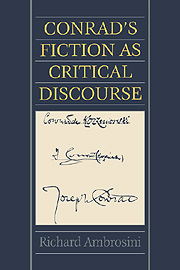Book contents
- Frontmatter
- Contents
- Acknowledgments
- List of abbreviations
- Introduction
- 1 The critical discourse: five tropes
- 2 Working on language and structure: alternative strategies in The Nigger of the “Narcissus” “Karain” and “Youth”
- 3 The mirror effect in “Heart of Darkness”
- 4 Lord Jim (I): the narrator as interpreter
- 5 Lord Jim (II): the narrator as reader
- Postscript
- Notes
- Bibliography
- Index
3 - The mirror effect in “Heart of Darkness”
Published online by Cambridge University Press: 05 January 2012
- Frontmatter
- Contents
- Acknowledgments
- List of abbreviations
- Introduction
- 1 The critical discourse: five tropes
- 2 Working on language and structure: alternative strategies in The Nigger of the “Narcissus” “Karain” and “Youth”
- 3 The mirror effect in “Heart of Darkness”
- 4 Lord Jim (I): the narrator as interpreter
- 5 Lord Jim (II): the narrator as reader
- Postscript
- Notes
- Bibliography
- Index
Summary
“Heart of Darkness” is the furthest point in Conrad's attempt to communicate his intended effect through a suggestive language paralleled by an extra-fictional communication. In carrying out this effort, he used the narrative strategies he had been defining through “Karain” and “Youth” for an explicit discussion of his interpretation of his own writing. And, in effect, he uses for the first time in “Heart of Darkness” the frame narrator's involvement and Marlow's commentary to probe the theoretical assumptions underlying the possibility of communicating past subjective experience.
An interpretation of the critical discourse which directs the readers' attention to the difficulties the writer had in re-creating his subjective experience helps clarify how Conrad gave shape to the suggestively impressionistic language he had first envisaged in the preface to The Nigger of the “Narcissus.” The effectiveness of the tale's language is the result of a narrative strategy based on the interweaving of two languages. Through an impressionistic account, Conrad makes the readers “hear … feel and … see” (NoN, x) scenes and characters from the past. On the other hand, through Marlow's commentary, Conrad strives after a different kind of accuracy: that precision which he calls, in his non-fictional writings, “fidelity to the truth of my own sensations.”
- Type
- Chapter
- Information
- Conrad's Fiction as Critical Discourse , pp. 68 - 99Publisher: Cambridge University PressPrint publication year: 1991



